If you’re a collector of saxophones, here’s one that might be of interest to you. Adolphe Sax’s son—Adolphe Edouard Sax (1859-1945)—continued on his father’s business of building saxophones. Every once in a while rare Sax originals—either Adolphe or Adolphe Edouard—pop up for sale on eBay, or other online sites. This morning I happened to see an original Sax, alto saxophone on eBay.
Source: eBay.com
The seller of this rare horn is in Germany, and he provides the text in both German and English. I’ll do the same, because it is slightly different. The seller says:
Vintage Adolphe Sax Alto Saxophon – SN 16849, ca. 1911
Ein wunderschönes Original-Saxophon vom Sohn des Adolphe Sax: Adolphe-Edouard Sax. Aufgrund des in der Gravur angegebenen Straßennamens und Höhe der Seriennummer auf ein Baujahr nach 1908 zu datieren, eventuell 1911. Gravur: Medaille D’ OR 1900, Adolphe SAX, Feur de l’Académie Nle de musique, 84. RUE MYRHA, Paris, Made in France, 16849.
Mit Perlmutteinlagen und Original-S-Bogen. Im Erhaltungszustand keine Beulen und nur wenige Kratzer, die Vernickelung(?) ist auf den Griffstellen/Klappen runtergegriffen aber auf dem Korpus jedoch zu >95% erhalten. Das Saxophon ist spielbereit und besitzt einen Klasse ausgewogenen Sound. Siehe Fotos.
Fragen werden aber gerne beantwortet. Versand nur als versichertes Paket (bis 25.00 EUR): 30,- EUR innerhalb Deutschland.
The seller mentions something in German that he doesn’t in English, so I thought I’d point it out. He thinks the instrument is nickel plated, but is not sure.
In the following text, the seller uses the word corpus while referring to the plating. Corpus means body.
Vintage Adolphe Sax Alto Saxophone – SN 16849, approx. 1911
A beautiful all original Alto Saxophone made by the son of Adolphe Sax (inventor of the saxophone): Adolphe-Edouard. The instrument was dated after 1908 (location of the Company: Rue Myrha), maybe about 1911. Engraving: Medaille D’ OR 1900, Adolphe SAX, Feur de l’Académie Nle de musique, 84. RUE MYRHA, Paris, Made in France, 16849. The company of the inventor of the saxophone was sold to Selmer.
The sax does include its original neck and pearl key inlays. It has a wonderful sound and is in good playing condition. The plating on the corpus is about 95% intact, only touching points are without plating. The sax shows no dents and dings. This original is hard to find, usually you can find it only in a museum!
International bidders are welcome, see attached scans! Please ask if you have questions! Please ask for shipment costs, only insured parcels will be shipped.
Source: eBay.com
Source: eBay.com
This sax has a G# trill key. I’m guessing the other key is some form of a fork Eb key, but I might be wrong. Anyone know for sure what it is?
Source: eBay.com
Source: eBay.com
Although the stamping is hard to make out in this shot, it is the same as on the Adolphe Edouard soprano that the National Music Museum has in its collection. That soprano is serial #15352, and is circa 1900 – 1907 according to the Museum.
Source: eBay.com
Source: eBay.com
Source: eBay.com
The sax is keyed from low B…
Source: eBay.com
to high F.
Source: eBay.com
This alto also has an automatic octave key.
Source: eBay.com
Source: eBay.com
The auction for this vintage, Adolphe Edouard Sax original alto runs until November 9. Bids are to start at €3,700.00—which eBay estimates to be $5,142.63 US. At the time of writing, there were no bids yet on this rare horn.

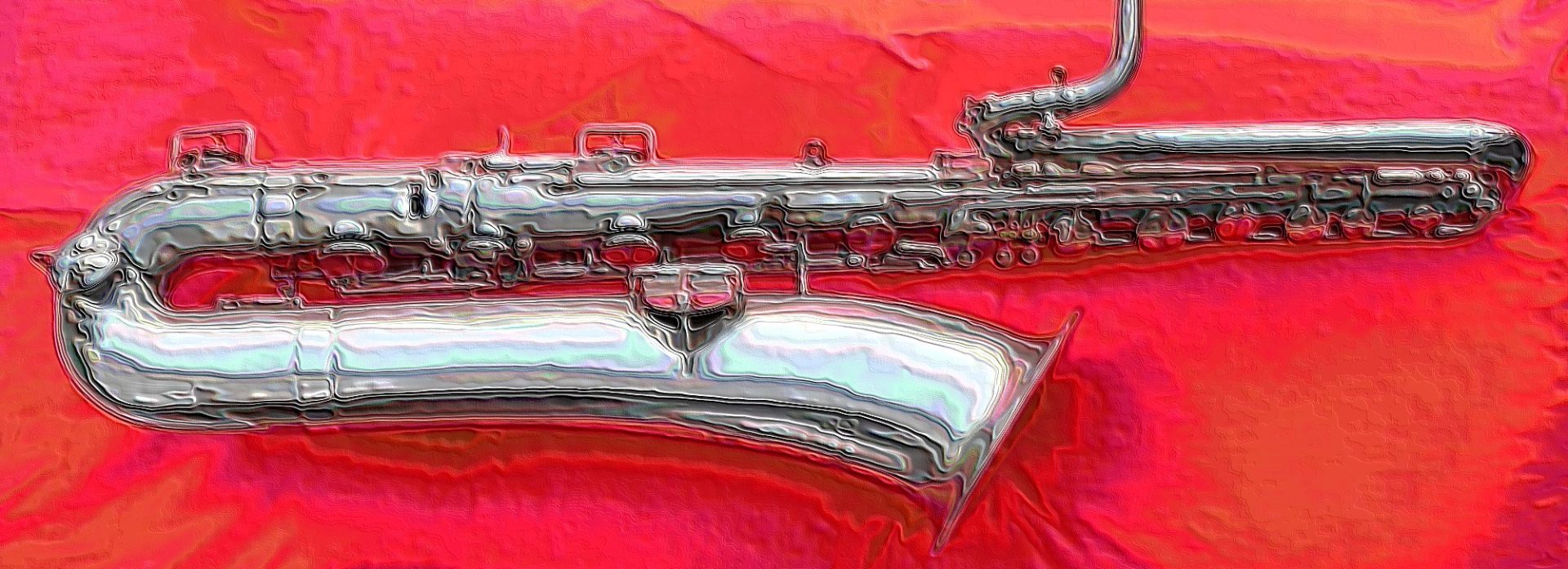

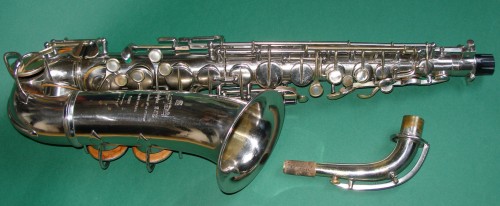


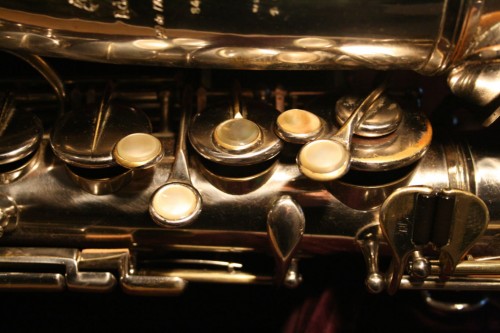
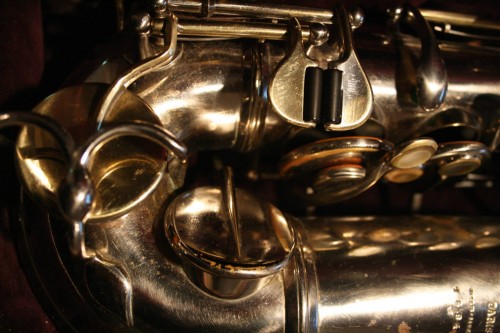
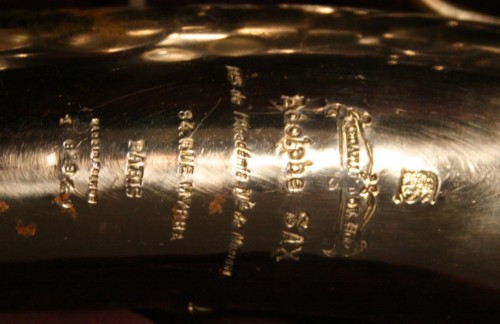
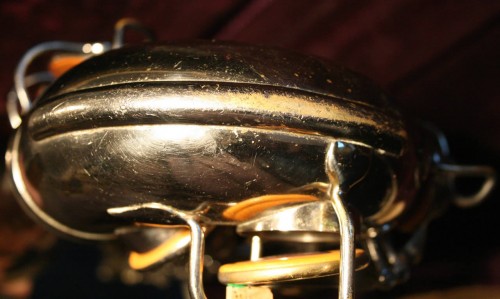
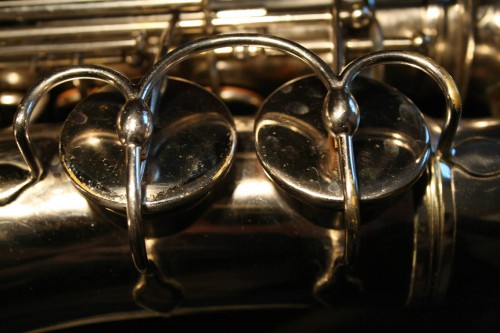
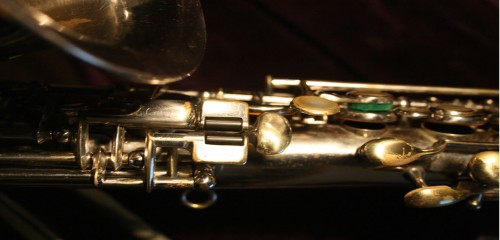
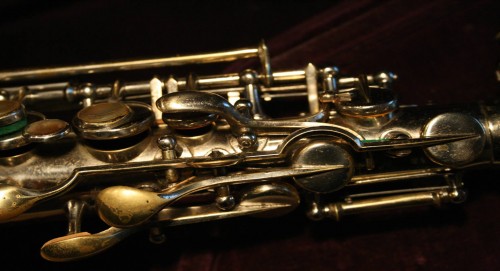
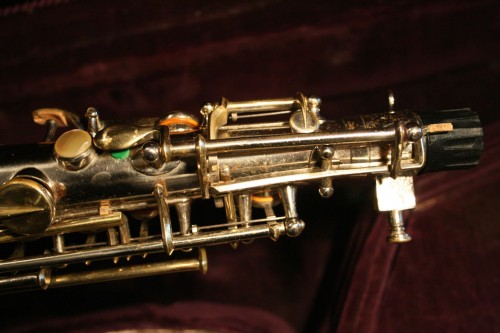


Dear Helen,
Because I would like to sell a saxophone , complete with his original mouthpiece made in rosewood ,in very good condition ,with mark : Saxophone alto en mi b breveté /// Adolphe Sax à Paris /// Fteur de la Mson Miltre de l’Empereur with the logo AS and the serial number of the year 1861,could you please inform me the value of this very beautiful historical saxophone who – I guess – could only be seen in museum,and to give me contact with persons who could be interrested to buy it!
Thank you for your help!
Yours with my best regards. N.A from France.
Hallo leute
ich bin in besitzt eine Saxophone sax medaille d or 1900
84 rue myrha
1er GRAND PRIX
DE
Le Facture Instrumentale
Medaille D´or 1900
Adolphe SAX
84. RUE MYRHA
PARIS
No. 770
I would really appreciate any help. Thanks.
Rob
1er GRAND PRIX
DE
Le Facture Instrumentale
Medaille D´or 1900
Adolphe SAX
84. RUE MYRHA
PARIS
No. 770
can any one tell me the value of it.
I would really appreciate any help. Thanks.
Ravindra Dabhi
Hi there Ravindra. Welcome to my site.
I’m sorry that I didn’t reply to your first comment yet. I’ve been quite busy, and have fallen behind in my replies. That doesn’t mean that I hadn’t begun to do some research however. I had started researching your horn, but ran into some difficulties because of its very early serial number.
It will take me some more time to try and research your horn some more. Due to performances, rehearsals, and commitments like this, my time for other things is really limited.
I hope you understand, and I will try and get to this as soon as possible.
Regards,
Helen
Helen, I’m assuming this sax is one of the Selmer made ones, they started the serial numbers again… :headbang: So if it’s got rollers and a low serial number, first guess is post Selmer take over. These Selmer made ‘A Sax’ saxes also have another number on the body. I’ve seen speculation that it’s a Selmer workshop/serial number, but it doesn’t seem to fit properly.
Rob, souunds like you have one of the ones made by Selmer after they took over the Sax business. It’s not clear whether they have a Selmer body or Sax one. Suspicion is that some of the early ones were old stock from the sax days, but with the new serial number range applied. Some have the curved sax style keygards, others something more workmanlike. I can’t remember off hand, but I think there were only a couple of thousand altos and tenors made before the Sax name was discontinued.
Hi Rob.
OK, I did some digging and found out a little about your saxophone. It was indeed most likely built buy Adolphe Edouard Sax (not by Selmer as was suggested).
Its engraving is conistent with tenor #746 that was auctioned off in 1996. The website Adolphe Sax Instruments offers up the following about that tenor:
As for value, that is quite a bit harder to pin down. I would suggest you try and use this page of my website to help you come up with a price estimate. It really all comes down to the horn’s condition.
Is it an alto, tenor, baritone, or soprano? I don’t think you mentioned that in either of your posts. That too of course plays a major role in the value of your horn.
At last I find some info on this sax. I own one. I am a singer and my uncle used to be a band leader in England. He left me his alto sax. I would really like to know its value. Here are the specs:
1er GRAND PRIX
DE
Le Facture Instrumentale
Medaille D´or 1900
Adolphe SAX
84. RUE MYRHA
PARIS
No. 536
I would really appreciate any help. Thanks.
Rob
Hi Rob. Welcome to my site.
Sorry to be so late in answering you question. I’ve been really busy with a lot of non-sax related stuff. I’m seemingly never catching up.
OK, so now to your sax… I would be happy to do some research for you on your horn, but I would need to see some photos. The serial # is very low, so this could mean one of a few different things. Photos would help with identifying what features it has, and therefore approximately when it was made.
Please send any photos you have to my gmail account. This way I won’t have any problem with file size. For this kind of stuff, the bigger the better, since I can’t tell details from small photos. Please check out this page on the main portion of my site for info on what kinds of photos are most helpful.
Once we know what we’re dealing with, then I might be able to give you an idea of what similar horns have listed for in the past. But, in vintage horns, condition is everything. This is another reason photos are important. Without good pics of the various areas of the sax, I really can’t give you much information.
I hope this has been helpful.
Regards,
Helen
Update: This sax did not sell. It received 0 bids by the time the auction ended. The result was the same when it was re-listed for the same price.
Thanks Mal-2 & Randy for confirming my suspicions about the extra key being a variation on the Eb.
This is certainly a very pretty sax. It will be interesting if it indeed sells, or if the price is a bit on the high side. Since it is located in Europe, where prices tend to be higher than over here, I’m not sure that it won’t find a new home.
Helen,
This is one of the really good Adolphe Edouard Sax saxophones, before Selmer bought the Sax company and trademarks. Keyed from low Bb to high F, it’s pretty much a modern saxophone. The previous comments are correct – the right hand mechanism is like the Buffet “Apogee” system for the alternate low Eb.
The front F mechanism is different because it lifts both the high F key and the high E key. It was probably intended to facilitate a trill from high Eb to high F.
This horn is exactly like the one pictured in Jaap Kool’s book “The Saxophone.” He used it to point out “secondary parabolic curves” in the bore. I have always considered Kool’s theory horse dookey. I think the “bulges” and “parabolic curves” Jaap Kool saw in the old horn he examined were due to a bent body and overzealous dent removal. I’m willing to bet the body of this saxophone has a bore that’s straight as an arrow.
Anyway, the keyguards are pretty, the horn seems to be in good shape, and I wish it were mine.
I do know what that extra touch between RH2 and RH3 is — it’s the early 20th century Evette-Schaefer mechanism for “fork Eb”. Instead of putting a small key around the back, they put a hole right through the middle of the RH3 pad and stacked another pad on top of that. (While this is no longer an option on a modern horn, a similar mechanism for the high C# is quite common on today’s soprano saxophones.) I doubt that it sounds any less fuzzy than the original fork Eb mechanism, as the hole isn’t any bigger.
The idea is that instead of using the X X X X O X fingering for fork Eb, you would use X X X X X O but with RH2 slid down onto the alternate pearl. The disadvantage is obvious — you have to take a finger out of position. The advantage is primarily mechanical, as the pad-on-pad is triggered directly by the pressure of RH3 and assuring a good seal is a simpler matter than when the fork Eb is around back and triggered by lever from RH2. However, this retains the original fork Eb disadvantage that you cannot do a true X O X right hand fingering pattern, which removes some altissimo patterns from consideration (namely X O X X O X for altissimo G).
If you really care, you’ll find its use detailed to a painful degree on the fingering chart found in the Universal Method.
I also have my doubts about the dating of this instrument for two reasons — the automatic octave pip switching (which wasn’t fully embraced until c. 1914, at least in the U.S.), and the front F key. I do not know when the front F was first offered, but I know it’s MISSING from a lot of horns as late as the late 1920s.
:2cents: